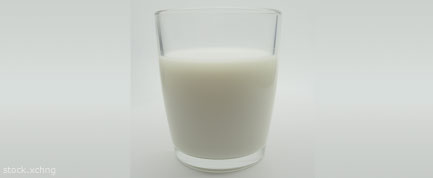Love of Milk Dated Back to 6000 B.C.

The answer to “Got milk?” just got a little older: A new study indicates that people have been milking cattle and other domesticated animals as well as processing and storing milk products for 2,000 years longer than originally thought. A group of scientists studied thousands of pottery shards from sites all over the Near East and the Balkans and tested them for residues of milk fats. They found that milk was already being used and processed by societies there by the seventh millennium B.C. Previously, the earliest evidence of milk use came from the fifth millennium, though cattle, sheep and goats had already been domesticated by the eighth millennium. The traces of milk fats can survive on the pottery, even after being buried for thousands of years, because the fats are hydrophobic, so they don't dissolve in water, and they are produced in large amounts, said study leader Richard Evershed of the University of Bristol in England. Ceramic vessels are very porous, so if you store or cook animal products in them, "the pottery vessels pick up that organic matter like crazy," Evershed told LiveScience. The residues don't indicate the presence of milk itself, as those would decay away very quickly, but instead suggest more processed dairy substances, such as butter, yogurt, ghee (or clarified butter), and possibly cheese, though cheese is largely altered by microbes and so may not leave a recognizable dairy signature, Evershed said. Evershed and his colleagues were surprised that they found the most residues in sites in Anatolia (most of modern Turkey), which lies outside the traditional Fertile Crescent region where agriculture was first developed. To see why milk production seemed to be more important in Anatolia than in the other sites, the team looked at animal bones and found a strong correlation between the number of cattle bones present at a site and the prevalence of milk residues. "So it looks like there's a linkage between the importance of dairy, of cattle and the production of dairy products," Evershed said, pointing out that this is much the situation in the world today, where cattle are the main source of dairy products. Evershed said that the region in Anatolia around the Sea of Marmara was supposedly very lush, and so "it might have been that the conditions were just right for grazing cattle." Because Anatolia is outside of the Fertile Crescent, it also suggests that the various pieces of domestication didn't evolve in a linear order and that some aspects, such as milk production, may have only boomed in the right places when the conditions were ripe. The results of the study are detailed in the Aug. 7 issue of the journal Nature.
- Top 10 Ancient Capitals
- History's Most Overlooked Mysteries
- Why Is Cow's Milk White?
Get the world’s most fascinating discoveries delivered straight to your inbox.

Andrea Thompson is an associate editor at Scientific American, where she covers sustainability, energy and the environment. Prior to that, she was a senior writer covering climate science at Climate Central and a reporter and editor at Live Science, where she primarily covered Earth science and the environment. She holds a graduate degree in science health and environmental reporting from New York University, as well as a bachelor of science and and masters of science in atmospheric chemistry from the Georgia Institute of Technology.


